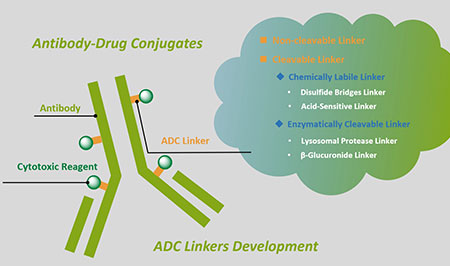1.Understanding How the Stability of the Thiol-Maleimide Linkage Impacts the Pharmacokinetics of Lysine-Linked Antibody-Maytansinoid Conjugates.
Ponte JF;Sun X;Yoder NC;Fishkin N;Laleau R;Coccia J;Lanieri L;Bogalhas M;Wang L;Wilhelm S;Widdison W;Pinkas J;Keating TA;Chari R;Erickson HK;Lambert JM Bioconjug Chem. 2016 Jul 20;27(7):1588-98. doi: 10.1021/acs.bioconjchem.6b00117. Epub 2016 Jun 20.
Antibody-drug conjugates (ADCs) have become a widely investigated modality for cancer therapy, in part due to the clinical findings with ado-trastuzumab emtansine (Kadcyla). Ado-trastuzumab emtansine utilizes the Ab-SMCC-DM1 format, in which the thiol-functionalized maytansinoid cytotoxic agent, DM1, is linked to the antibody (Ab) via the maleimide moiety of the heterobifunctional SMCC linker. The pharmacokinetic (PK) data for ado-trastuzumab emtansine point to a faster clearance for the ADC than for total antibody. Cytotoxic agent release in plasma has been reported with nonmaytansinoid, cysteine-linked ADCs via thiol-maleimide exchange, for example, brentuximab vedotin. For Ab-SMCC-DM1 ADCs, however, the main catabolite reported is lysine-SMCC-DM1, the expected product of intracellular antibody proteolysis. To understand these observations better, we conducted a series of studies to examine the stability of the thiol-maleimide linkage, utilizing the EGFR-targeting conjugate, J2898A-SMCC-DM1, and comparing it with a control ADC made with a noncleavable linker that lacked a thiol-maleimide adduct (J2898A-(CH2)3-DM). We employed radiolabeled ADCs to directly measure both the antibody and the ADC components in plasma.
2.Bystander killing effect of DS-8201a, a novel anti-human epidermal growth factor receptor 2 antibody-drug conjugate, in tumors with human epidermal growth factor receptor 2 heterogeneity.
Ogitani Y;Hagihara K;Oitate M;Naito H;Agatsuma T Cancer Sci. 2016 Jul;107(7):1039-46. doi: 10.1111/cas.12966. Epub 2016 Jun 22.
Antibody-drug conjugates deliver anticancer agents selectively and efficiently to tumor tissue and have significant antitumor efficacy with a wide therapeutic window. DS-8201a is a human epidermal growth factor receptor 2 (HER2)-targeting antibody-drug conjugate prepared using a novel linker-payload system with a potent topoisomerase I inhibitor, exatecan derivative (DX-8951 derivative, DXd). It was effective against trastuzumab emtansine (T-DM1)-insensitive patient-derived xenograft models with both high and low HER2 expression. In this study, the bystander killing effect of DS-8201a was evaluated and compared with that of T-DM1. We confirmed that the payload of DS-8201a, DXd (1), was highly membrane-permeable whereas that of T-DM1, Lys-SMCC-DM1, had a low level of permeability. Under a coculture condition of HER2-positive KPL-4 cells and negative MDA-MB-468 cells in vitro, DS-8201a killed both cells, whereas T-DM1 and an antibody-drug conjugate with a low permeable payload, anti-HER2-DXd (2), did not. In vivo evaluation was carried out using mice inoculated with a mixture of HER2-positive NCI-N87 cells and HER2-negative MDA-MB-468-Luc cells by using an in vivo imaging system. In vivo, DS-8201a reduced the luciferase signal of the mice, indicating suppression of the MDA-MB-468-Luc population; however, T-DM1 and anti-HER2-DXd (2) did not.
3.A novel anti-CD37 antibody-drug conjugate with multiple anti-tumor mechanisms for the treatment of B-cell malignancies.
Deckert J;Park PU;Chicklas S;Yi Y;Li M;Lai KC;Mayo MF;Carrigan CN;Erickson HK;Pinkas J;Lutz RJ;Chittenden T;Lambert JM Blood. 2013 Nov 14;122(20):3500-10. doi: 10.1182/blood-2013-05-505685. Epub 2013 Sep 3.
CD37 has gathered renewed interest as a therapeutic target in non-Hodgkin lymphoma (NHL) and chronic lymphocytic leukemia (CLL); however, CD37-directed antibody-drug conjugates (ADCs) have not been explored. Here, we identified a novel anti-CD37 antibody, K7153A, with potent in vitro activity against B-cell lines through multiple mechanisms including apoptosis induction, antibody-dependent cellular cytotoxicity, antibody-dependent cellular phagocytosis, and complement-dependent cytotoxicity. The antibody was conjugated to the maytansinoid, DM1, a potent antimicrotubule agent, via the thioether linker, N-succinimidyl-4-(N-maleimidomethyl)cyclohexane-1-carboxylate (SMCC), and the resulting ADC, IMGN529, retained the intrinsic antibody activities and showed enhanced cytotoxic activity from targeted payload delivery. In lymphoma cell lines, IMGN529 induced G2/M cell cycle arrest after internalization and lysosomal processing to lysine-N(ε)-SMCC-DM1 as the sole intracellular maytansinoid metabolite. IMGN529 was highly active against subcutaneous B-cell tumor xenografts in severe combined immunodeficient mice with comparable or better activity than rituximab, a combination of cyclophosphamide, vincristine, and prednisone, or bendamustine.







